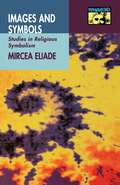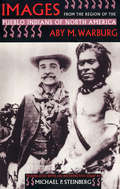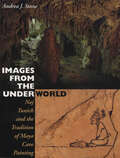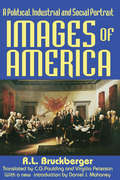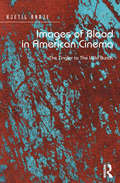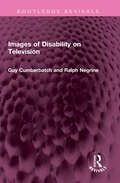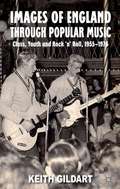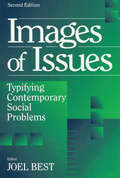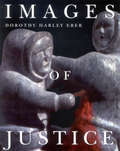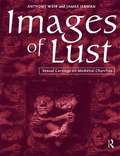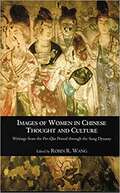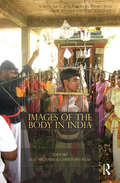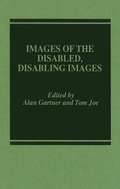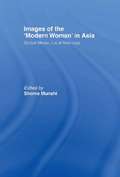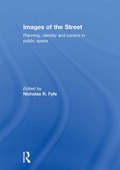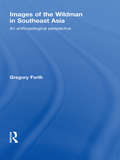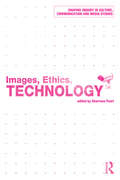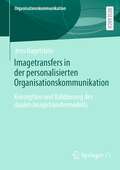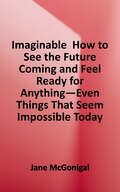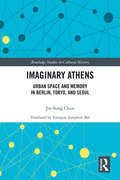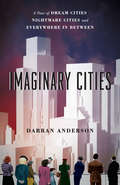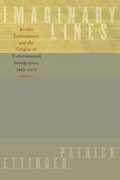- Table View
- List View
Images and Symbols: Studies in Religious Symbolism
by Mircea EliadeMircea Eliade--one of the most renowned expositors of the psychology of religion, mythology, and magic--shows that myth and symbol constitute a mode of thought that not only came before that of discursive and logical reasoning, but is still an essential function of human consciousness. He describes and analyzes some of the most powerful and ubiquitous symbols that have ruled the mythological thinking of East and West in many times and at many levels of cultural development.
Images and Symbols: Studies in Religious Symbolism (Bollingen Series #684)
by Mircea EliadeMircea Eliade--one of the most renowned expositors of the psychology of religion, mythology, and magic--shows that myth and symbol constitute a mode of thought that not only came before that of discursive and logical reasoning, but is still an essential function of human consciousness. He describes and analyzes some of the most powerful and ubiquitous symbols that have ruled the mythological thinking of East and West in many times and at many levels of cultural development.
Images from Paradise: The Visual Communication of the European Union's Federalist Utopia
by Eszter SalgóDrawing upon the disciplines of politics, anthropology, psychoanalysis, aesthetics and cinema studies, Salgó presents a new way of looking at the "art of European unification." The official visual narratives of the European Union constitute the main object of inquiry – the iconography of the new series of euro banknotes and the videos through which the supranational elite seek to generate "collective effervescence," allow for a European carnival to take place, and prompt citizens to pledge allegiance to the sacred dogma of the "ever closer union," thereby strengthening the mythical sources of the organization's legitimacy. The author seeks to illustrate how and why the federalist utopia turned into a political soteriology after the outbreak of the 2008 crisis.
Images from the Region of the Pueblo Indians of North America
by Aby M. WarburgAby M. Warburg (1866–1929) is recognized not only as one of the century’s preeminent art and Renaissance historians but also as a founder of twentieth-century methods in iconology and cultural studies in general. Warburg’s 1923 lecture, first published in German in 1988 and now available in the first complete English translation, offers at once a window on his career, a formative statement of his cultural history of modernity, and a document in the ethnography of the American Southwest. This edition includes thirty-nine photographs, many of them originally presented as slides with the speech, and a rich interpretive essay by the translator.
Images from the Underworld: Naj Tunich and the Tradition of Maya Cave Painting
by Andrea J. StoneAn in-depth look at Maya cave painting from Preconquest times to the Colonial period, plus a complete visual catalog of the cave art of Naj Tunich.In 1979, a Kekchi Maya Indian accidentally discovered the entrance to Naj Tunich, a deep cave in the Maya Mountains of El Peten, Guatemala. One of the world&’s few deep caves that contain rock art, Naj Tunich features figural images and hieroglyphic inscriptions that have helped to revolutionize our understanding of ancient Maya art and ritual.In this book, Andrea Stone takes a comprehensive look at Maya cave painting from Preconquest times to the Colonial period. After surveying Mesoamerican cave and rock painting sites and discussing all twenty-five known painted caves in the Maya area, she focuses extensively on Naj Tunich. Her text analyzes the images and inscriptions, while photographs and line drawings provide a complete visual catalog of the cave art, some of which has been subsequently destroyed by vandals.This important new body of images and texts enlarges our understanding of the Maya view of sacred landscape and the role of caves in ritual. It will be important reading for all students of the Maya, as well as for others interested in cave art and in human relationships with the natural environment.&“Not only an extraordinarily detailed and insightful analysis of the painted representations and texts found in Naj Tunich but also a complete survey of all known Maya painted caves. . . . A major monograph on a major Maya site. For completeness of presentation, for clarity of writing, and for depth and scope of analysis, [Images from the Underworld] is a model of what a final report should be.&” —Journal of Anthropological Research
Images from the Underworld: Naj Tunich and the Tradition of Maya Cave Painting
by Andrea J. StoneAn in-depth look at Maya cave painting from Preconquest times to the Colonial period, plus a complete visual catalog of the cave art of Naj Tunich.In 1979, a Kekchi Maya Indian accidentally discovered the entrance to Naj Tunich, a deep cave in the Maya Mountains of El Peten, Guatemala. One of the world&’s few deep caves that contain rock art, Naj Tunich features figural images and hieroglyphic inscriptions that have helped to revolutionize our understanding of ancient Maya art and ritual.In this book, Andrea Stone takes a comprehensive look at Maya cave painting from Preconquest times to the Colonial period. After surveying Mesoamerican cave and rock painting sites and discussing all twenty-five known painted caves in the Maya area, she focuses extensively on Naj Tunich. Her text analyzes the images and inscriptions, while photographs and line drawings provide a complete visual catalog of the cave art, some of which has been subsequently destroyed by vandals.This important new body of images and texts enlarges our understanding of the Maya view of sacred landscape and the role of caves in ritual. It will be important reading for all students of the Maya, as well as for others interested in cave art and in human relationships with the natural environment.&“Not only an extraordinarily detailed and insightful analysis of the painted representations and texts found in Naj Tunich but also a complete survey of all known Maya painted caves. . . . A major monograph on a major Maya site. For completeness of presentation, for clarity of writing, and for depth and scope of analysis, [Images from the Underworld] is a model of what a final report should be.&” —Journal of Anthropological Research
Images of America: A Political, Industrial and Social Portrait
by R.L. Bruckberger"Either America is the hope of the world, or it is nothing. Th ere are those who have begun to despair of the West. It is for them that I am writing." Bruckberger's book has been compared by many to Tocqueville's Democracy in America. In both works, Americans see themselves through the sympathetic, sometimes critical eyes of a Frenchman. Bruckberger, as chaplain general of the French Resistance during World War II, was a scholar who lived a life of action, and a priest who knew the life of the spirit. He begins with a celebration of the American past, but also off ers a clear warning for the future.The book was written after Bruckberger's eight years in the United States, during which he thought deeply about the country, and came to love and admire it. He sees what others have not, and his heroes are, in most instances, not the ones normally chosen. As seen from the perspective of the old Europe, the ideas and ideals that have shaped the history and character of America, take on a new meaning. The result is an image of America that is as enlightening as it is surprising.Bruckberger believes America brings to the Western heritage an essential spark, one vital for the angry and perilous post-World War II world, and one equally important today. That is America's regard for the individual, for the non-abstract, living human being. This theme, contrasted with what Bruckberger sees as the heresy of Europe--the subordination of human beings to abstraction is developed with wit and insight.
Images of Blood in American Cinema: The Tingler to The Wild Bunch
by Kjetil RødjeThrough studying images of blood in film from the mid-1950s to the end of the 1960s, this path-breaking book explores how blood as an (audio)visual cinematic element went from predominately operating as a signifier, providing audiences with information about a film’s plot and characters, to increasingly operating in terms of affect, potentially evoking visceral and embodied responses in viewers. Using films such as The Return of Dracula, The Tingler, Blood Feast, Two Thousand Maniacs, Color Me Blood Red, Bonnie and Clyde, and The Wild Bunch, Rødje takes a novel approach to film history by following one (audio)visual element through an exploration that traverses established standards for film production and reception. This study does not heed distinctions regarding to genres (horror, western, gangster) or models of film production (exploitation, independent, studio productions) but rather maps the operations of cinematic images across marginal as well as more traditionally esteemed cinematic territories. The result is a book that rethinks and reassembles cinematic practices as well as aesthetics, and as such invites new ways to investigate how cinematic images enter relations with other images as well as with audiences.
Images of Disability on Television (Routledge Revivals)
by Guy Cumberbatch Ralph NegrineFirst published in 1992, Images of Disability on Television examines the frequency and nature of disability on British and American television and how it is perceived and presented by programme makers. Attitudes held by those closest to the issues – disabled people, their carers, and television producers and writers – are presented as the result of interviews and discussions. There is an increasingly strong sentiment that television has got it wrong as far as disability is concerned and does not play its proper role in allowing the non-disabled to understand fully the world of disabled people. This book provides information to promote greater understanding of the needs of the disabled people in television portrayal and opens up possibilities for a change in attitudes. It will be valuable reading for students, researchers and lecturers in the social sciences, communication studies, and media studies.
Images of England Through Popular Music: Class, Youth and Rock 'n' Roll, 1955-1976
by Keith GildartDrawing on archival sources and oral testimony, Keith Gildart examines the ways in which popular music played an important role in reflecting and shaping social identities and working-class cultures and - through a focus on rock 'n' roll, rhythm & blues, punk, mod subculture, and glam rock - created a sense of crisis in English society.
Images of Issues: Typifying Contemporary Social Problems (Social Problems And Social Issues Ser.)
by Joel BestConstructionist theory describes and analyzes social problems as emerging through the efforts of claimsmakers who bring issues to public attention. By typifying a problem and characterizing it as a particular sort, claimsmakers can shape policymaking and public response to the problem. Th is new edition of Images of Issues addresses claimsmaking in the 1990s, featuring such issues as fathers' rights, stalking, sexual abuse by the clergy, hate crimes, multicultural education, factory farming, and concluding with an expanded discussion of the theoretical debate over constructionism.
Images of Justice: A Legal History Of The Northwest Territories And Nunavut As Traced Through The Yellowknife Courthouse Collection Of Inuit Sculpture (McGill-Queen's Indigenous and Northern Studies #154)
by Dorothy Harley EberImages of Justice resonates with voices of the North and comes alive through interviews with many of those involved in the cases - defendants, judges, and prosecutors. Eber also provides valuable information on the little-known carvers who created these remarkable works of art. At a time when alternative legal systems for Native peoples are being debated, Images of Justice provides a lively, accessible account of the northern courts, their evolution, and their future in a changing northern society.
Images of Lust: Sexual Carvings on Medieval Churches
by James Jerman Anthony WeirSexually explicit sculptures may be found on a number of medieval churches in France and Spain. This fascinating study examines the origins and purposes of these sculptures, viewing them not as magical fertility symbols, nor even as idols of ancient pre-Christian religions, but as serious works that dealt with the sexual customs and salvation of medieval folk, and thus gave support to the Church's moral teachings.
Images of Women in Chinese Thought and Culture: Writings from The Pre-Qin Period Through the Song Dynasty
by Robin WangThis rich collection of writings--many translated especially for this volume and some available in English for the first time--provides a journey through the history of Chinese culture, tracing the Chinese understanding of women as elucidated in writings spanning more than two thousand years. From the earliest oracle bone inscriptions of the Pre-Qin period through the poems and stories of the Song Dynasty, these works shed light on Chinese images of women and their roles in society in terms of such topics as human nature, cosmology, gender, and virtue.
Images of the Body in India: South Asian and European Perspectives on Rituals and Performativity
by Christoph Wulf Axel MichaelsThis intriguing book engages with the concept of the body in its cultural context by acknowledging and demonstrating that the human body is understood differently in Western and Indian cultures. The contributors go on to show that any attempt to put forward a single concept of the body within Indian culture would be misleading. Divided into three parts, the book examines the considerable and often conflicting variations in body images and body concepts. In Part One the contributors focus on the representation of the body in religious and philosophical texts; representations that emerged from reading, translating and interpreting classical writings from diverse historical and anthropological approaches. Through predominantly ethnographic studies, Part Two explores the role of the body in narratives and ritual performance, from dance to ritualistic ceremonies. Visualisation processes of the body are examined in Part Three, focusing on developments in modern and contemporary periods: from visual practices at the Mughal court, to the multiple bodies of the bride, and the influence of new media. This volume is a fascinating collection of articles for those in the fields of sociology and anthropology, history, religion, cultural studies and South Asian studies.
Images of the Disabled, Disabling Images
by Alan Gartner Tom JoeIn this collection of a dozen essays, writers with strong backgrounds in the disability rights movement examine the roots of public attitudes toward the disabled. Several essays consider portrayals of people with disabilities in literature, film, and journalism. Others explore social policy toward the disabled in education, employment, and health-care. Nat Hentoff's powerful piece, ""The Awful Privacy of Baby Doe," expresses the author's outrage over the case of a child born with spina bifida who was denied treatment because doctors persuaded her parents that she would be better off dead.
Images of the Modern Woman in Asia: Global Media, Local Meanings
by Shoma MunshiIn examining the links between gender and the media, this volume asks questions involving the relationship between global media flows, gender and modernity in the region.
Images of the Street: Planning, Identity and Control in Public Space
by Nicholas R. FyfeImages of the Street captures the vitality, excitements and tensions of the street. Using examples from the U.K, India, Australia and North America the contributors draw on research in cultural geography, sociolgy, cultural studies and planning to explore the making and meaning of urban space.Among the themes examined are:1.the way streetscapes are shaped by interplay between politics, planning and local political economy 2.social differences of individuals experiences' of the street 3.how social identities are shaped and represented in fiction and film 4.the meaning and significance of streets as settings to play out social practices 5.how social life is regulated on the street, formerly by police and indirectly through architecture and urban design
Images of the Wildman in Southeast Asia: An Anthropological Perspective
by Gregory ForthThe book examines ‘wildmen’, images of hairy humanlike creatures known to rural villagers and other local people in Southeast Asia and elsewhere. Sometimes described in considerable detail, the creatures are reported as still living or as having survived until recent times. The aim of the book is to discover the source of these representations and their status in local systems of knowledge, partly in relation to distinct categories of spiritual beings, known animals, and other human groups. It explores images of the wildman from throughout Southeast Asia, focusing in particular on the Indonesian islands, and beyond, including the Asian mainland, Africa, North America, Africa, Australia, and Oceania. The book reveals how, in Southeast Asia and elsewhere, ‘wildmen’ cannot readily be explained as imaginary constructs rooted in cultural values and social institutions, nor as simply another kind of ‘spirit’. Also critically examined is a view of such figures as fundamentally similar expressions of a pan-human mental ‘archetype’. Forth concludes that many Asian and African figures are grounded in experience or memories of anthropoid apes supplemented by encounters with ethnic others. Representations developed among European immigrants (including the North American ‘sasquatch’) are, in part, similarly traceable to an indirect knowledge of primates, informed by long-standing European representations of hairy humans that have coloured western views of non-western peoples and which may themselves originate in ancient experience of apes. At the same time, the book demonstrates how Indonesian and other Malayo-Polynesian images cannot be explained in the same way, and explores the possibility of these reflecting an ancient experience of non-sapiens hominins.
Images, Ethics, Technology (Shaping Inquiry in Culture, Communication and Media Studies)
by Sharrona PearlImages, Ethics, Technology explores the changing ethical implications of images and the ways they are communicated and understood. It emphasises how images change not only through their modes of representation, but through our relationship to them. In order to understand images, we must understand how they are produced, communicated, and displayed. Each of the 14 essays chart the relationship to technology as part of a larger complex social and cultural matrix, highlighting how these relations constrain and enable notions of responsibility with respect to images and what they represent. They demonstrate that as technology develops and changes, the images themselves change, not just with respect to content, but in the very meanings and indices they produce. This is a collection that not only asks: who speaks for the art? But also: who speaks for the witnesses, the cameras, the documented, the landscape, the institutional platforms, the taboos, those wishing to be forgotten, those being seen and the experience of viewing itself? Images, Ethics, Technology is ideal for advanced level students and researchers in media and communications, visual culture and cultural studies.
Imagetransfers in der personalisierten Organisationskommunikation: Konzeption und Validierung des dualen Imagetransfermodells (Organisationskommunikation)
by Jens HagelsteinIn diesem Buch werden Imagetransfers in der personalisierten Organisationskommunikation untersucht. Dabei wird das duale Imagetransfermodell entwickelt, das affektive und kognitive, explizite und implizite sowie kontrollierte und automatische Imagetransfers erfasst, und anschließend in drei Experimentalstudien überprüft. Aus den theoretischen und empirischen Erträgen der Arbeit werden Handlungsempfehlungen für das organisationale Kommunikationsmanagement abgeleitet.Der AutorJens Hagelstein ist wissenschaftlicher Mitarbeiter am Institut für Kommunikations- und Medienwissenschaft der Universität Leipzig. Seine Forschungsschwerpunkte umfassen strategische Kommunikation, Public Relations und Werbekommunikation.
Imaginable: How to See the Future Coming and Feel Ready for Anything--Even Things That Seem Impossible Today
by Jane McGonigalWorld-renowned future forecaster, game designer, and NEW YORK TIMES bestselling author Jane McGonigal gives us the tool s to imagine the future without fear. An accessible, optimistic field guide to the future. --San Francisco Chronicle "Reading this book is like sitting down with a creative, optimistic friend--and getting up as a new version of yourself.""--Daniel H. Pink, New York Times bestselling author of When The COVID-19 pandemic, increasingly frequent climate disasters, a new war -- events we might have called ""unimaginable"" or ""unthinkable"" in the past are now reality. Today it feels more challenging than ever to feel unafraid, hopeful, and equipped to face the future with optimism. How do we map out our lives when it seems impossible to predict what the world will be like next week, let alone next year or next decade? What we need now are strategies to help us recover our confidence and creativity in facing uncertain futures.In Imaginable, Jane McGonigal draws on the latest scientific research in psychology and neuroscience to show us how to train our minds to think the unthinkable and imagine the unimaginable. She invites us to play with the provocative thought experiments and future simulations she's designed exclusively for this book, with the goal to: - Build our collective imagination so that we can dive into the future and envision, in surprising detail, what our lives will look like ten years from now - Develop the courage and vision to solve problems creatively - Take actions and make decisions that will help shape the future we desire - Access "urgent optimism," an unstoppable force within each of us that activates our sense of agency Imaginable teaches us to be fearless, resilient, and bold in realizing a world with possibilities we cannot yet imagine--until reading this transformative, inspiring, and necessary book .
Imaginary Athens: Urban Space and Memory in Berlin, Tokyo, and Seoul (Routledge Studies in Cultural History #97)
by Jin-Sung ChunThis book comprehensively examines architecture, urban planning, and civic perception in three modern cities as they transform into national capitals through an entangled, transnational process that involves an imaginative geography based on embellished memories of classical Athens. Schinkel’s classicist architecture in Berlin, especially the principle of tectonics at its core, came to be adopted effectively at faraway cities in East Asia, merging with the notion of national polity as Imperial Japan sought to reinvent Tokyo and mutating into an inevitable reflection of modern civilization upon reaching colonial Seoul, all of which give reason to ruminate over the phantasmagoria of modernity.
Imaginary Cities: A Tour of Dream Cities, Nightmare Cities, and Everywhere in Between
by Darran AndersonFor as long as humans have gathered in cities, those cities have had their shining—or shadowy—counterparts. Imaginary cities, potential cities, future cities, perfect cities. It is as if the city itself, its inescapable gritty reality and elbow-to-elbow nature, demands we call into being some alternative, yearned-for better place. This book is about those cities. It’s neither a history of grand plans nor a literary exploration of the utopian impulse, but rather something different, hybrid, idiosyncratic. It’s a magpie’s book, full of characters and incidents and ideas drawn from cities real and imagined around the globe and throughout history. Thomas More’s allegorical island shares space with Soviet mega-planning; Marco Polo links up with James Joyce’s meticulously imagined Dublin; the medieval land of Cockaigne meets the hopeful future of Star Trek. With Darran Anderson as our guide, we find common themes and recurring dreams, tied to the seemingly ineluctable problems of our actual cities, of poverty and exclusion and waste and destruction. And that’s where Imaginary Cities becomes more than a mere—if ecstatically entertaining—intellectual exercise: for, as Anderson says, “If a city can be imagined into being, it can be re-imagined.” Every architect, philosopher, artist, writer, planner, or citizen who dreams up an imaginary city offers lessons for our real ones; harnessing those flights of hopeful fancy can help us improve the streets where we live. Though it shares DNA with books as disparate as Calvino’s Invisible Cities and Jane Jacobs’s Death and Life of Great American Cities, there’s no other book quite like Imaginary Cities. After reading it, you’ll walk the streets of your city—real or imagined—with fresh eyes.
Imaginary Lines
by Patrick EttingerAlthough popularly conceived as a relatively recent phenomenon, patterns of immigrant smuggling and undocumented entry across American land borders first emerged in the late nineteenth century. Ingenious smugglers and immigrants, long and remote boundary lines, and strong push-and-pull factors created porous borders then, much as they do now. Historian Patrick Ettinger offers the first comprehensive historical study of evolving border enforcement efforts on American land borders at the turn of the twentieth century. He traces the origins of widespread immigrant smuggling and illicit entry on the northern and southern United States borders at a time when English, Irish, Chinese, Italian, Russian, Lebanese, Japanese, Greek, and, later, Mexican migrants created various "backdoors" into the United States. No other work looks so closely at the sweeping, if often ineffectual, innovations in federal border enforcement practices designed to stem these flows. From upstate Maine to Puget Sound, from San Diego to the Lower Rio Grande Valley in Texas, federal officials struggled to adapt national immigration policies to challenging local conditions, all the while battling wits with resourceful smugglers and determined immigrants. In effect, the period saw the simultaneous "drawing" and "erasing" of the official border, and its gradual articulation and elaboration in the midst of consistently successful efforts to undermine it.

